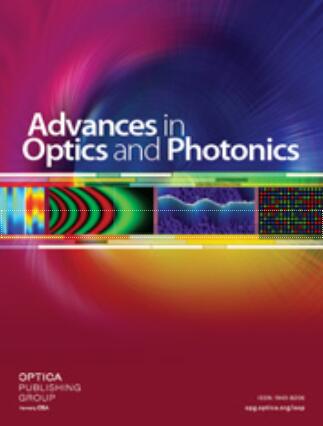Principles, fundamentals, and applications of programmable integrated photonics
IF 23.8
1区 物理与天体物理
Q1 OPTICS
引用次数: 34
Abstract
Programmable integrated photonics is an emerging new paradigm that aims at designing common integrated optical hardware resource configurations, capable of implementing an unconstrained variety of functionalities by suitable programming, following a parallel but not identical path to that of integrated electronics in the past two decades of the last century. Programmable integrated photonics is raising considerable interest, as it is driven by the surge of a considerable number of new applications in the fields of telecommunications, quantum information processing, sensing, and neurophotonics, calling for flexible, reconfigurable, low-cost, compact, and low-power-consuming devices that can cooperate with integrated electronic devices to overcome the limitation expected by the demise of Moore’s Law. Integrated photonic devices exploiting full programmability are expected to scale from application-specific photonic chips (featuring a relatively low number of functionalities) up to very complex application-agnostic complex subsystems much in the same way as field programmable gate arrays and microprocessors operate in electronics. Two main differences need to be considered. First, as opposed to integrated electronics, programmable integrated photonics will carry analog operations over the signals to be processed. Second, the scale of integration density will be several orders of magnitude smaller due to the physical limitations imposed by the wavelength ratio of electrons and light wave photons. The success of programmable integrated photonics will depend on leveraging the properties of integrated photonic devices and, in particular, on research into suitable interconnection hardware architectures that can offer a very high spatial regularity as well as the possibility of independently setting (with a very low power consumption) the interconnection state of each connecting element. Integrated multiport interferometers and waveguide meshes provide regular and periodic geometries, formed by replicating unit elements and cells, respectively. In the case of waveguide meshes, the cells can take the form of a square, hexagon, or triangle, among other configurations. Each side of the cell is formed by two integrated waveguides connected by means of a Mach–Zehnder interferometer or a tunable directional coupler that can be operated by means of an output control signal as a crossbar switch or as a variable coupler with independent power division ratio and phase shift. In this paper, we provide the basic foundations and principles behind the construction of these complex programmable circuits. We also review some practical aspects that limit the programming and scalability of programmable integrated photonics and provide an overview of some of the most salient applications demonstrated so far.可编程集成光子学的原理、基本原理和应用
可编程集成光子学是一种新兴的新范式,旨在设计通用的集成光学硬件资源配置,能够通过适当的编程实现各种不受限制的功能,与上世纪过去二十年的集成电子器件走平行但不相同的路径。可编程集成光子学引起了人们的极大兴趣,因为它是由电信、量子信息处理、传感和神经光子学领域大量新应用的激增所驱动的,这些应用要求灵活、可重构、低成本、紧凑、,以及可以与集成电子设备合作以克服摩尔定律消亡所预期的限制的低功耗设备。利用完全可编程性的集成光子器件有望从特定应用的光子芯片(具有相对较低数量的功能)扩展到非常复杂的应用不可知的复杂子系统,这与现场可编程门阵列和微处理器在电子设备中的操作方式非常相似。需要考虑两个主要差异。首先,与集成电子相反,可编程集成光子学将对待处理的信号进行模拟操作。其次,由于电子和光波光子的波长比所施加的物理限制,积分密度的规模将小几个数量级。可编程集成光子的成功将取决于利用集成光子器件的特性,特别是对合适的互连硬件架构的研究,该架构可以提供非常高的空间规则性,以及独立设置(以非常低的功耗)每个连接元件的互连状态的可能性。集成的多端口干涉仪和波导网格分别通过复制单元元件和单元来提供规则和周期性的几何形状。在波导网格的情况下,单元可以采用正方形、六边形或三角形以及其他配置的形式。单元的每一侧由两个集成波导形成,这两个波导通过马赫-曾德尔干涉仪或可调谐定向耦合器连接,可通过输出控制信号作为交叉开关或具有独立功分比和相移的可变耦合器进行操作。在本文中,我们提供了这些复杂可编程电路的基本基础和原理。我们还回顾了限制可编程集成光子学编程和可扩展性的一些实际方面,并概述了迄今为止展示的一些最显著的应用。
本文章由计算机程序翻译,如有差异,请以英文原文为准。
求助全文
约1分钟内获得全文
求助全文
来源期刊

Advances in Optics and Photonics
OPTICS-
CiteScore
56.60
自引率
0.00%
发文量
13
期刊介绍:
Advances in Optics and Photonics (AOP) is an all-electronic journal that publishes comprehensive review articles and multimedia tutorials. It is suitable for students, researchers, faculty, business professionals, and engineers interested in optics and photonics. The content of the journal covers advancements in these fields, ranging from fundamental science to engineering applications.
The journal aims to capture the most significant developments in optics and photonics. It achieves this through long review articles and comprehensive tutorials written by prominent and respected authors who are at the forefront of their fields.
The journal goes beyond traditional text-based articles by enhancing the content with multimedia elements, such as animation and video. This multimedia approach helps to enhance the understanding and visualization of complex concepts.
AOP offers dedicated article preparation and peer-review support to assist authors throughout the publication process. This support ensures that the articles meet the journal's standards and are well-received by readers.
Additionally, AOP welcomes comments on published review articles, encouraging further discussions and insights from the scientific community.
In summary, Advances in Optics and Photonics is a comprehensive journal that provides authoritative and accessible content on advancements in optics and photonics. With its diverse range of articles, multimedia enhancements, and dedicated support, AOP serves as a valuable resource for professionals and researchers in these fields.
 求助内容:
求助内容: 应助结果提醒方式:
应助结果提醒方式:


